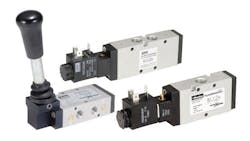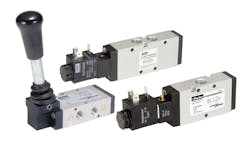In-line solenoid air valve resists wear
Viking Lite Series in-line solenoid valves feature Wear Compensating System, consisting of a spool seal that expands radially under pressure, thus maintaining sealing contact with the valve bore. WSC extends cycle life and reliability; requires no lubrication; and provides lower pilot pressures for fast response and less wear. The valves operate at pressure to 145 psig and temperatures from 14° to 122° F. The Series comes in three and four-way two-position with single or double solenoids; four-way three-position double-solenoid functions, and 1/8, 1/4, or 3/8 port sizes with a standard 22-pin three-pin DIN solenoid connector. The valves mount individually or collectively on an IEM bar manifold.Parker Hannifin Corp., Pneumatic Div., 269.629.5000, www.parker.com/pneumatics


